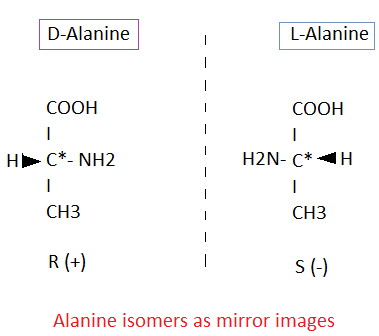
D-alanine differs from L-alanine with respect to
A. Configuration
B. Chemical formula
C. Number of \[N{{H}_{2}}\] groups
D. Number of \[COOH\] groups
Answer
549.6k+ views
Hint: D-alanine and L-alanine are enantiomers. This means that they have the same mirror images. It is evident by the Fischer Projection formula. In this formula, D-alanine exhibits hydroxyl group towards the right and L-alanine exhibits hydroxyl group on the left. Both D-alanine and L-alanine are isomers of amino acid alanine.
Complete answer: Alanine is an important amino acid which is an amino group and a carboxylic acid group both attached to a central carbon atom. It also carries a methyl group as a side chain. Its scientific name is \[2-\]aminopropanoic acid. The codons that start with GC can encode for alanine in the human body, thus it is a non-essential amino acid. It has two main isomers named D-alanine and L-alanine.

The L-isomer of alanine or L-alanine is incorporated to form proteins. Its structure is left-handed. The hydroxyl group of L-alanine lies on the left side. The D-isomer of alanine or D-alanine is used in the formation of bacterial cell walls, thus it occurs in polypeptides. It is also found in some peptide antibiotics. D-alanine forms an essential part of the tissues of Crustaceans and Mollusks. The hydroxyl group of D-alanine occurs on the right side of its structure. Both L-alanine and D-alanine are mirror images of each other. They differ in their configuration for the hydroxyl group. This can be understood by the Fischer formula. The Fischer representation of $3-D$ compounds in $2-D$ is used to differentiate between L and D molecules. In a Fischer projection, the second last carbon of D-sugars represents hydrogen on the left and hydroxyl on the right. On the other hand, the L-sugars depict hydrogen on the right and hydroxyl on the left.
Hence, the right answer is option A.
Note: The Glucose-alanine cycle plays an important role in between tissues and the liver. The alanine cycle also has been linked to diabetes. Alterations in the alanine cycle increase the levels of serum alanine aminotransferase or ALT. This abnormal increase is linked to the development of type II diabetes.
Complete answer: Alanine is an important amino acid which is an amino group and a carboxylic acid group both attached to a central carbon atom. It also carries a methyl group as a side chain. Its scientific name is \[2-\]aminopropanoic acid. The codons that start with GC can encode for alanine in the human body, thus it is a non-essential amino acid. It has two main isomers named D-alanine and L-alanine.

The L-isomer of alanine or L-alanine is incorporated to form proteins. Its structure is left-handed. The hydroxyl group of L-alanine lies on the left side. The D-isomer of alanine or D-alanine is used in the formation of bacterial cell walls, thus it occurs in polypeptides. It is also found in some peptide antibiotics. D-alanine forms an essential part of the tissues of Crustaceans and Mollusks. The hydroxyl group of D-alanine occurs on the right side of its structure. Both L-alanine and D-alanine are mirror images of each other. They differ in their configuration for the hydroxyl group. This can be understood by the Fischer formula. The Fischer representation of $3-D$ compounds in $2-D$ is used to differentiate between L and D molecules. In a Fischer projection, the second last carbon of D-sugars represents hydrogen on the left and hydroxyl on the right. On the other hand, the L-sugars depict hydrogen on the right and hydroxyl on the left.
Hence, the right answer is option A.
Note: The Glucose-alanine cycle plays an important role in between tissues and the liver. The alanine cycle also has been linked to diabetes. Alterations in the alanine cycle increase the levels of serum alanine aminotransferase or ALT. This abnormal increase is linked to the development of type II diabetes.
Recently Updated Pages
Master Class 11 Social Science: Engaging Questions & Answers for Success

Master Class 11 Physics: Engaging Questions & Answers for Success

Master Class 11 Maths: Engaging Questions & Answers for Success

Master Class 11 Economics: Engaging Questions & Answers for Success

Master Class 11 Computer Science: Engaging Questions & Answers for Success

Master Class 11 Chemistry: Engaging Questions & Answers for Success

Trending doubts
What is meant by exothermic and endothermic reactions class 11 chemistry CBSE

10 examples of friction in our daily life

One Metric ton is equal to kg A 10000 B 1000 C 100 class 11 physics CBSE

Difference Between Prokaryotic Cells and Eukaryotic Cells

1 Quintal is equal to a 110 kg b 10 kg c 100kg d 1000 class 11 physics CBSE

Draw a diagram of nephron and explain its structur class 11 biology CBSE




